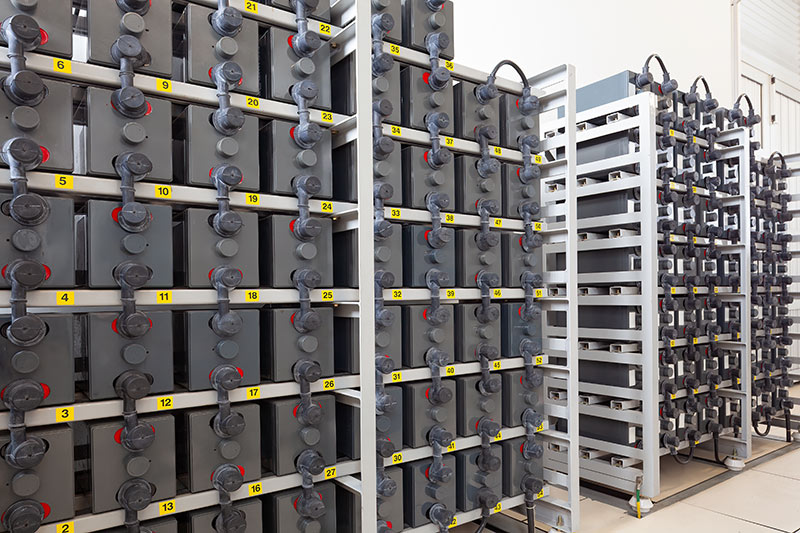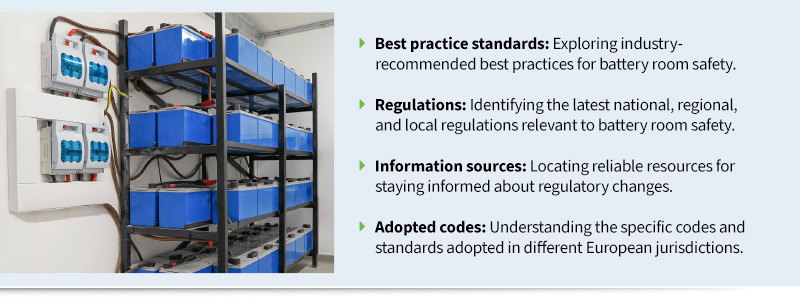
Ensuring Battery Room Safety in Europe: Navigating Standards and Best Practices
Battery room safety demands rigorous attention across European industries, yet safety requirements are governed by an intricate network of national, regional and local regulations. These rules, often informed by international standards and industry best practices, are frequently updated to reflect evolving technologies and emerging safety concerns.
Understanding and implementing proper safety measures helps facility managers, operators and stakeholders maintain compliance and protect their operations. Local authorities, insurance providers, and other regulatory bodies often require compliance with specific standards, making it essential to stay informed and proactive. This guide provides a detailed roadmap through European battery room safety requirements, to help organizations navigate both current and emerging standards.
Subsidiarity in EU Regulation
Understanding the structure of EU regulation provides crucial context for implementing battery room safety measures effectively. The principle of subsidiarity in EU law emphasizes decision-making at the lowest level of government. For battery safety, local jurisdictions typically enforce safety regulations, with national governments stepping in only when harmonization requires it.
This regulatory structure enables local authorities to establish specific requirements for ventilation or spill containment while maintaining consistency with broader EU safety guidelines.
For example, local rules may dictate ventilation requirements or spill containment measures, while EU-wide standards establish overarching safety guidelines. This balance allows for both flexibility to meet local needs and consistency across member states, ensuring a high level of safety.
IEC Standards: A Global Benchmark
International standards create a foundation for consistent safety practices across borders. The International Electrotechnical Commission (IEC) guides battery room safety standards through comprehensive frameworks covering design, construction, certification, and site safety standards. These standards encompass several critical areas:
- IEC 62485-2: Focuses on safely operating stationary secondary battery systems, providing comprehensive guidelines for installation and maintenance
- Standards for Emerging Technologies: Specific guidelines addressing lithium-ion batteries, which present unique safety challenges due to their high energy density
- UPS and Emergency Systems: Dedicated standards for lead-acid batteries used in critical backup power applications
Risk and Hazard Analysis in Battery Room Safety
Safety implementation requires both systematic evaluation and practical action. The assessment process begins with identifying applicable standards like IEC 62485-2 and EN 50604, which establish baseline requirements for stationary battery installations.
Critical safety considerations include:
- Fire Safety Management: Implementation of suppression systems, strategic placement of extinguishers, and development of comprehensive emergency procedures
- Gas Detection & Reduction Systems: Installation of ventilation systems designed to prevent dangerous gas accumulation, particularly hydrogen
- Containment Systems: Development of robust electrolyte spill prevention and management protocols
- Thermal Management: Implementation of early detection and prevention systems for thermal runaway events

Mitigating Risks in Battery Room Environments
Risk mitigation in battery room environments requires a comprehensive, multi-layered approach that combines detection systems, protective equipment and engineered controls. Modern facilities integrate these elements into a cohesive safety system that provides both early warning capabilities and active protection measures.
Steps like installing hydrogen detection systems, providing PPE and ensuring proper ventilation are vital to minimizing risks.
Personal and Site Safety Measures
The success of any battery room safety program depends on both human factors and physical infrastructure working in harmony. This dual approach ensures comprehensive protection through both active and passive safety measures.
- Personal Protection Battery room operators must have access to appropriate PPE, including gloves, goggles and aprons. Training is crucial, with personnel required to understand electrical hazards, safe work practices and emergency procedures. Certification or refresher courses may be necessary in high-risk areas.
- Site Protections Battery room design must account for environmental challenges and safety requirements. Essential elements include:
- Electrolyte-resistant flooring with appropriate containment systems
- Hydrogen Detection Systems and Ventilation systems designed to prevent hydrogen gas accumulation
- Measures to prevent ignition of flammable gases
- Temperature and humidity control systems
- Appropriate signage and warning systems
- Record Keeping and Certifications Documentation provides the foundation for demonstrating safety compliance while enabling continuous improvement of safety protocols. A well-maintained record system serves as both a legal shield and a tool for optimizing safety measures. Maintaining detailed records of inspections, maintenance and incidents is critical for demonstrating compliance. Certifications from recognized bodies further validate adherence to safety standards.
Authorities Having Jurisdiction (AHJs) often incorporate IEC 62485-2 principles into broader safety codes, ensuring a consistent approach to inspections and audits. Staying informed about AHJ requirements is vital for smooth compliance.
Insurance Company Influence
Beyond regulatory compliance, financial protection plays a crucial role in comprehensive battery room safety programs. Insurance providers serve as both stakeholders and safety partners in developing robust protection measures. Insurance providers significantly impact battery safety by:
- Assessing risks: Evaluating potential hazards and encouraging safety improvements.
- Enforcing compliance: Requiring adherence to standards as part of coverage conditions.
- Providing resources: Offering data sheets and recommendations for risk mitigation, such as those provided by FM Global.
Compliance with insurance requirements reduces the likelihood of property damage, business interruptions and denied claims.
Key Takeaways for Battery Room Safety in Europe:
European battery room safety presents complex challenges, yet structured approaches can help operators ensure compliance and protect their facilities. Success requires attention to several key areas:
- Organizations must understand and navigate the multi-layered regulatory landscape spanning local, national and EU requirements. Compliance with IEC standards, particularly IEC 62485-2, provides a strong foundation for safety practices.
- Safety measures encompass both human and technical elements – from proper training and PPE use to robust ventilation systems and spill containment. Regular documentation of inspections, maintenance, and incidents demonstrates ongoing compliance while supporting continuous improvement.
- Working closely with insurance providers adds another layer of protection through risk assessments and loss prevention recommendations. These partnerships help organizations prevent property damage and business interruptions while maintaining valid coverage.
By understanding these interconnected elements of battery room safety, stakeholders can build secure and sustainable energy storage systems throughout Europe. The white paper contains comprehensive details about the steps outlined in this blog. Download the white paper here.


